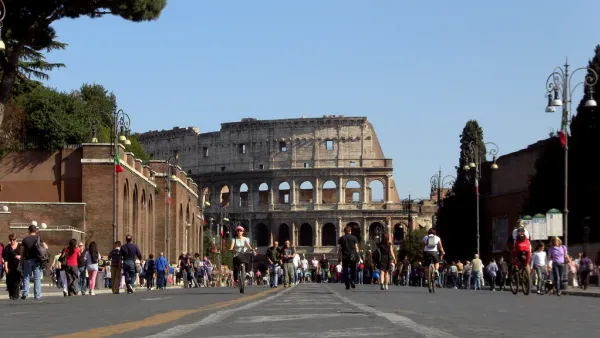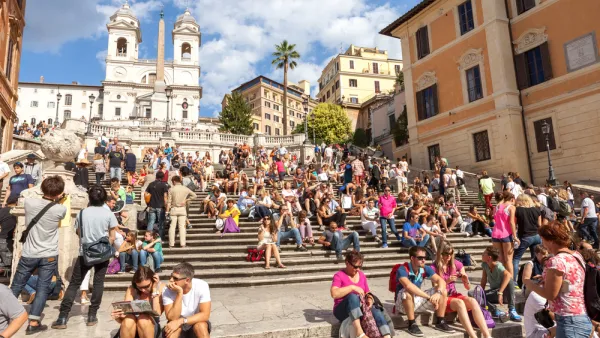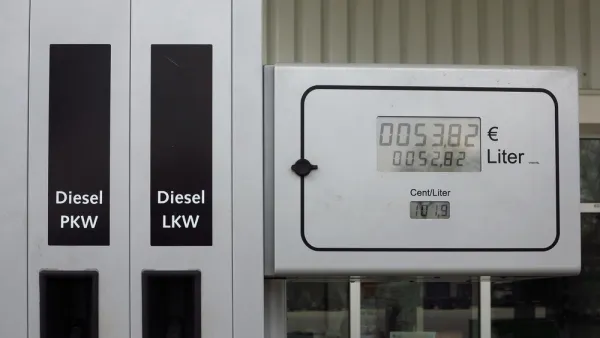Mayor Ignazio Marino of Rome has banned private vehicles from Via dei Fori Imperiali, built by Benito Mussolini to link his palace in Piazza Venezia to the Colosseum. Initially open to buses and taxis, it will eventually be completely pedestrianized.
Elisabetta Povoledo reports not only on the landmark project, but on the man behind it who appears to have a broader agenda as a former transplant surgeon who spent 20 years practicing in the U.S. Upon returning to Rome in 2006, "he plunged into politics and was elected to the Senate with the center-left Democratic Party". He chose not to run for re-election and easily beat the center-right incumbent mayor in June.
Perhaps it is only fitting that a leftist mayor would undo the destruction that the fascist dictator Mussolini did when he built the Via dei Fori Imperiali in the 1920s "as a marching avenue for triumphant troops", separating key historic forums as well as destroying "a densely populated area of Rome".
While the project has antagonized opponents, "especially the neighborhood's residents (concerned) with the anticipated spillover effect of closing a broad avenue used by as many as 1,600 motorists an hour", it also has attracted the support of preservationists and conservators who want to reconnect the Roman Forum to "the imperial forums of Trajan, Augustus, Caesar and Nerva" that are suffering decay caused by vehicle emissions and vibrations from traffic.
Mr. Marino cheerfully acknowledged that he would be “crucified” by citizens in the short term, but said it was worth fighting for his “vision of what I want this city to be in 30 years.” He added, “No one will remember who the mayor was in 2013, but everyone will appreciate the pedestrian area.”
Via dei Fori Imperiali is already pedestrianized on Sundays according to a description found in the Guide to Rome and Small Town Lazio.
It would appear that the mayor may have a wider urban planning agenda influenced by his medical background, and the street closure may not be his last project in his quest to "modify Romans' driving habits by encouraging more people to leave their vehicles at home. He said about 60 percent of Romans travel less than five kilometers a day — roughly three miles — to get to work."
“As a scientist, I find that numbers give a more clear and precise picture,” he said, and gave a few facts: 970 of 1,000 adult Romans have cars, compared with 340 in London, and the average speed of public transportation in Rome is less than 9 miles per hour. “One of the slowest in the Western world,” he said. “You could run faster.”
Contributor's addition: According to CIVITAS, Rome initiated a cordon (congestion) pricing scheme to a 4.8 sq. km area in 2001 and enlarged it in 2007. It has reduced traffic and increased public transit patronage.
FULL STORY: ROME JOURNAL: Road Through Roman History Creates Colossal Headache

Analysis: Cybertruck Fatality Rate Far Exceeds That of Ford Pinto
The Tesla Cybertruck was recalled seven times last year.

National Parks Layoffs Will Cause Communities to Lose Billions
Thousands of essential park workers were laid off this week, just before the busy spring break season.

Retro-silient?: America’s First “Eco-burb,” The Woodlands Turns 50
A master-planned community north of Houston offers lessons on green infrastructure and resilient design, but falls short of its founder’s lofty affordability and walkability goals.

Test News Post 1
This is a summary

Analysis: Cybertruck Fatality Rate Far Exceeds That of Ford Pinto
The Tesla Cybertruck was recalled seven times last year.

Test News Headline 46
Test for the image on the front page.
Urban Design for Planners 1: Software Tools
This six-course series explores essential urban design concepts using open source software and equips planners with the tools they need to participate fully in the urban design process.
Planning for Universal Design
Learn the tools for implementing Universal Design in planning regulations.
EMC Planning Group, Inc.
Planetizen
Planetizen
Mpact (formerly Rail~Volution)
Great Falls Development Authority, Inc.
HUDs Office of Policy Development and Research
NYU Wagner Graduate School of Public Service




























